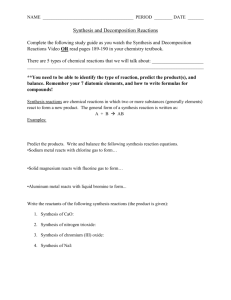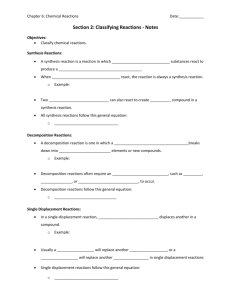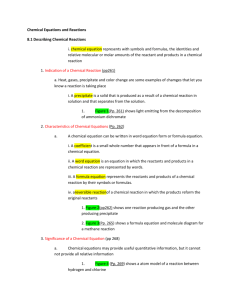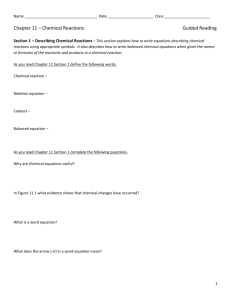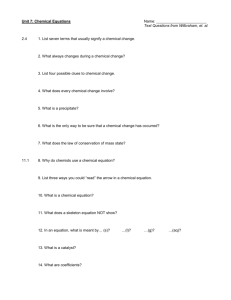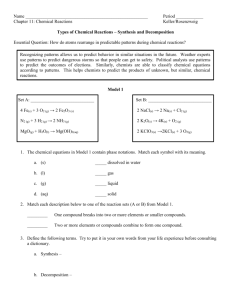PS 4.9 - S2TEM Centers SC
advertisement
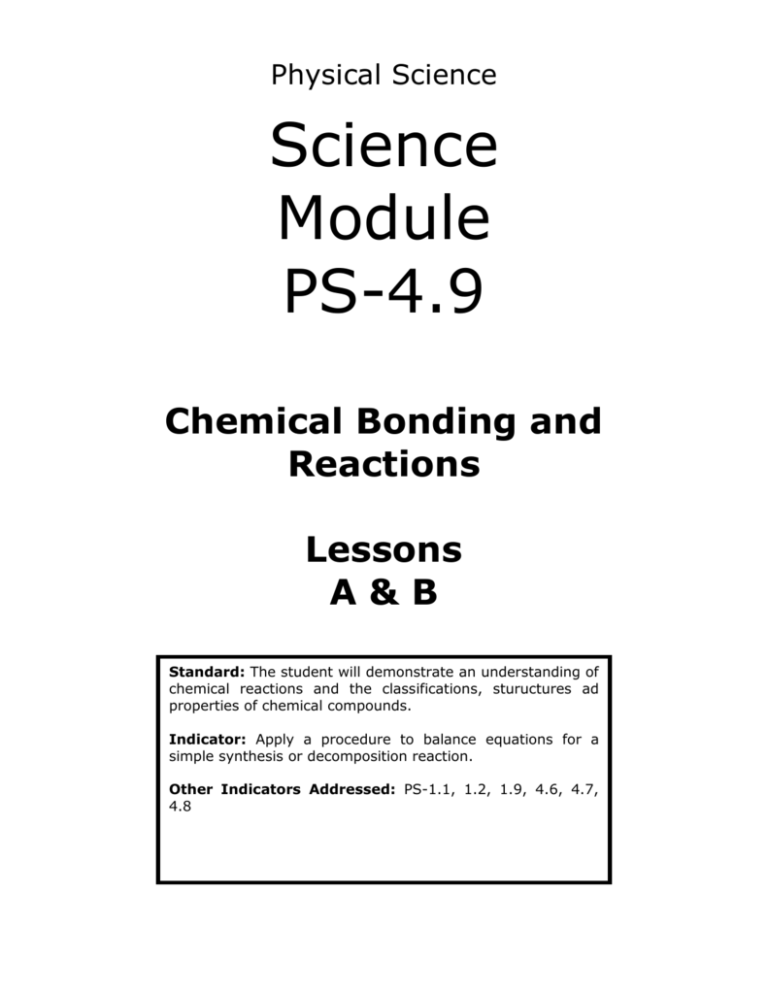
Physical Science Science Module PS-4.9 Chemical Bonding and Reactions Lessons A&B Standard: The student will demonstrate an understanding of chemical reactions and the classifications, stuructures ad properties of chemical compounds. Indicator: Apply a procedure to balance equations for a simple synthesis or decomposition reaction. Other Indicators Addressed: PS-1.1, 1.2, 1.9, 4.6, 4.7, 4.8 Instructional Progression: Students in the 7th grade “explained how a balanced chemical equation supports the law of conservation of matter.” (7-5.8) In Physical Science students will expand concept of balanced chemical equations. Students will write balanced formulas for some ionic compounds. Students will apply a procedure to manipulate coefficients to balance some chemical equations. Taxonomy level of indicator: 3.2-C Apply Procedural Knowledge Key Concepts: Formulas of substances: subscripts Balanced equation: coefficients Synthesis reaction equation Decomposition reaction equation Content Overview: It is essential for students to Understand that each substance has a formula showing its composition. It is essential to have the correct formula of each substance involved in a reaction before attempting to write a balanced equation. ○ Subscripts are part of the formula for a substance. ○ Subscripts indicate the number of atoms or ions in one chemical unit of that substance. Understand that a balanced equation represents a chemical reaction that rearranges atoms but does not create or destroy them. ○ For each element, the number of atoms on the reactant side must equal the number of atoms on the product side. ○ Coefficients indicate the number of units of each material that is involved in a reaction. Understand that subscripts are used to write the formula for a substance; the coefficient in front of the formula is then used to balance the equation after the formulas are written correctly. Manipulate only coefficients to balance the atoms in the equation for a simple synthesis reaction (two or more reactants combine to form one product) or decomposition reaction (a single reactant is broken apart into two or more products). ○ Example of a balanced synthesis reaction equation: (The coefficients are underlined in this example.) 4 Al + 3 O2 2 Al2O3 ○ Example of a balanced decomposition reaction equation: 2 NaCl 2 Na + Cl2 (If the coefficient is one, the number 1 is often not written down, such as Cl2, and the coefficient is understood to be one.) Teaching Lesson A: Reaction Types – Synthesis and Decomposition Introduction to the lesson: Students have learned to apply a procedure to balance simple equations. This lab activity will reinforce that learning. Lesson time: .5 day Materials Needed: Magnesium ribbon Steel wool (Fe) Tongs Matches Sea shell (CaCO3) Yeast Charcoal Hydrogen Peroxide (H2O2) Carbonated beverage (H2CO3) Hot plate Small plastic cups Phenolphthalein Essential Question: How can a laboratory activity support understanding of synthesis and decomposition reactions as well as how to balance equations for these reactions? Procedure: 1. Place a piece of shell on a hot plate over medium heat. Allow shell to remain on the heat until an observable change has occurred. Record observed changes. Save the product for a later experiment. 2. Fill the small cup approximately half full of a carbonated beverage. Record any changes observed for five minutes. 3. Fill a small cup approximately half full of hydrogen peroxide. Record any changes. Note the rate at which any changes occur. Add a pinch of yeast to the cup. Does the yeast have any effect on the rate of change noted before? 4. Using tongs, ignite the magnesium ribbon. DO NOT LOOK DIRECTLY AT THE MAGNESIUM RIBBON AS IT BURNS. Record the changes noted in the magnesium ribbon after it has been ignited. 5. Using tongs, ignite a small piece of steel wool. Record changed observed. 6. Using the powder obtained in step #1, add one or two drops of water. Test the result of the addition with a drop of phenolphathlein. 7. Report your results in the following data table. Data Table Step # Reactants Products Observations Type 1 2 3 4 5 6 Assessing the Lesson: Formative Assessment Questions: 1. Define a synthesis reaction. ___________________________________________________________ ___________________________________________________________ 1. Define a decomposition reaction. ___________________________________________________________ ___________________________________________________________ 2. Classify each of the reactions observed by type. ___________________________________________________________ Balance each of the following equations: Mg + Fe + O2 O2 CaO + CaCO3 MgO Fe3O4 H 2O CaO Ca(OH)2 + CO2 H2CO3 H2O H2O2 Answers: Step # H2O + + CO2 O2 Reactants Products Observations Type 1 CaCO3 CaO + CO2 Crumbled to powder decomposition 2 H2CO3 CO2 + Gas produced decomposition 3 H2O2 H2O + O2 Gas produced decomposition 4 Mg, O2 MgO synthesis 5 Fe Fe3O4 Bright light, white powder Burns brightly Ca(OH)2 Pink color Synthesis 6 O2 CaO, H2O H2 O synthesis Questions: 1. Define a synthesis reaction. One in which two or more reactants form one product. 2. Define a decomposition reaction. One in which one reactant forms two or more products. 3. Classify each of the above reactions by type. See Chart 4. Balance each of the following equations: 2Mg + O2 3Fe + 2O2 CaO + H 2O CaCO3 CaO H2CO3 H2O 2H2O2 2H2O Teaching Lesson B: 2 MgO Fe3O4 Ca(OH)2 + CO2 + + CO2 O2 Easy Electrolysis of Water Introduction to the Lesson: This simple lab activity will provide a procedure to observe a decomposition reaction. Lesson Time: 0.25 day Materials: 9-volt battery 2 small test tubes 400-mL beaker or jar Universal Indicator or cabbage juice 350 ml distilled water 1 teaspoon of sodium sulfate or Epsom’s salts (magnesium sulfate hydrate) Essential Question: How can a simple decomposition lab activity, using common chemicals, demonstrate the concept of chemical decomposition ? Procedure: 1. Dissolve the salt in the water. 2. Add sufficient Universal Indicator or cabbage juice to give a strong green color. 3. Fill the test tubes completely with the solution and invert them into the beaker of solution so that no air is trapped in the tubes. 4. Carefully lower the battery into the beaker and stand it against the side of the beaker. 5. Maneuver the test tubes so that each one covers a terminal of the battery. They can lean against the side of the beaker. 6. Observe for 5-10 minutes. The solution over the (-) terminal will turn blue as hydrogen gas is formed. The solution over the (+) terminal will turn pink as oxygen gas is formed. 7. Note the amounts of gas in each tube. Is that to be expected? 8. When sufficient gas has been collected, one can demonstrate the pop test with the hydrogen and the glowing splint test for oxygen. O2 (+) H2 (-) battery Assessing the Lesson: Formative Assessment Questions 1. What are the products of the reaction? 2. Why did the test tube over the (-) terminal turn blue? 3. Why did the test tube over the (+) terminal turn pink? 4. How do the volumes of the two gases compare? 5. Write the balanced chemical equation for this reaction. 6. How do the coefficients in the balanced equation compare with the volumes of each gas formed? Additional Instructional Considerations: Variations and Questions Same as above except use NaCl as the salt. What are the products now? Compare the gas volumes and explain. Are the indicator colors the same? Explain what you see. Same as above except use KI or NaBr as the salt. Explain all your observations. Same as above except use cabbage juice or bromothymol blue as the indicator. Explain all your observations. If you had used H2SO4 instead of the salt, how would the results have differed? Assessment 1: EOC Type Questions 1. What number should precede H2 in the chemical equation below in order for the equation to be balanced? ___ H2 + N2 →2NH3 A. 1 B. 2 C. 3 D. 4 2. What number should precede H2 in the chemical equation below in order for the equation to be balanced? ___ H2 + N2 →2NH3 A. 1 B. 2 C. 3 D. 4 3. Look at the following equation. 2Al(s) + 3CuCl2(aq) � 2AlCl3(aq) +3Cu(s) This is an example of what type of reaction? A. decomposition B. double displacement C. single displacement D. synthesis 4. When this equation is correctly balanced, the coefficient of the AlCl3 will be A. 1 B. 2 C. 4 D. 6 5 Which reaction type best describes the reaction shown above? A. combination C. single replacement B. decomposition D. combustion 6. The type of reaction represented by the above equation isA. single-replacement C. synthesis B. double-replacement D. decomposition 7. What type of reaction does this illustration represent? . decomposition b. synthesis c. single-replacement d. double-replacement 8. The coefficients of the balanced equation for the reaction illustrated above are: A. 1, 1, 1 C. 2, 1, 2 B. 1, 1, 2 D. 2, 2, 1 9. Which of the following is the balanced equation for the reaction shown above? A. Al + H2SO4 → Al2(SO4)3 + H2 B. 2Al + 3H2SO4 → Al2(SO4)3 + 3H2 C. 2Al + 3H2SO4 → Al2(SO4)3 + H2 D. 2Al + H2SO4 → Al2(SO4)3 + H2 10. The best model for a decomposition reaction isA. C. B. D. 11. When the equation above is balanced, the coefficient of the hydrochloric acid will be A. 2 C. 4 B. 3 D. 6 12. A. 1, 1, 1, 1 B. 2, 1, 1, 2 C. 3, 1, 3, 2 D. 3, 2, 2, 1 13. 14. What type of reaction is represented here? A. single replacement C. synthesis B. double replacement D. decomposition Which of the following models is s synthesis reaction? A. C. B. D. Answers: 1. C 2. C 3. C 4. B 5. C 6. A 7. A 8. D 9. B 10. A 11. D 12. C 13. B 14. C Content Area: Science SOUTH CAROLINA SUPPORT SYSTEM INSTRUCTIONAL GUIDE Science Inquiry Skills-These standards should be addressed during the first few weeks of school and revisited throughout each unit. Physical Science Recommended Days of Instruction: 1 (one day equals 90 min) Standard(s) addressed: PS-4 The student will demonstrate an understanding of chemical reactions and the classifications, structures, and properties of chemical compounds. Structure and Properties of Atoms Indicator PS–4.9 Apply a procedure to balance equations for a simple synthesis or decomposition reaction. Recommended Resources SC Science Standards Support Guide www.ed.sc.gov/apps/cso/standards/su pdocs_hs.cfm? Physical Science Textbook (see appendix for correlations to standards) See FunBased Learning This site gives instructions for writing formulas and balancing equations. Do it all in one hour! FunBased Learning http://funbasedlearning.com/chemistr y/default.htm Balancing Act section for worksheets http://sciencespot.net/Pages/classche m.html#Anchor-47857 A great site for balancing equations Suggested Instructional Strategies Module 4.9 Lesson A Reaction Types- Synthesis and Decomposition-Lab Lesson B Easy Electrolysis of Water Lab Assessment Guidelines Assessment 1 EOC Type Questions The objective of this indicator is to apply the procedure for balancing a synthesis or a decomposition chemical equation, therefore, the primary focus of assessment should be to know the procedure for balancing the equations and apply it to the situations of balancing simple synthesis and decomposition reactions. In addition to apply, assessment may require students to Recognize balanced equations; Identify the number of Indicator Recommended Resources http://www.sciencespot.net/Pages/kdz chem.html Streamline SC Elements of Chemistry: Compounds and Reactions Chemical Reactions (3:29) Physical Science Series: Chemical Reactions Chemical Equations (1:53) Four Types of Chemical Reactions (3:12) Simply Science: Reaction Equations Formation Reactions (4:06) Naming Compounds and Balancing Equations (5:33) Decomposition Reactions (2:17) Suggested Instructional Strategies Assessment Guidelines each type of atom on each side; Recall that the number of each type of atom will remain the same; Exemplify synthesis and decomposition equations.
